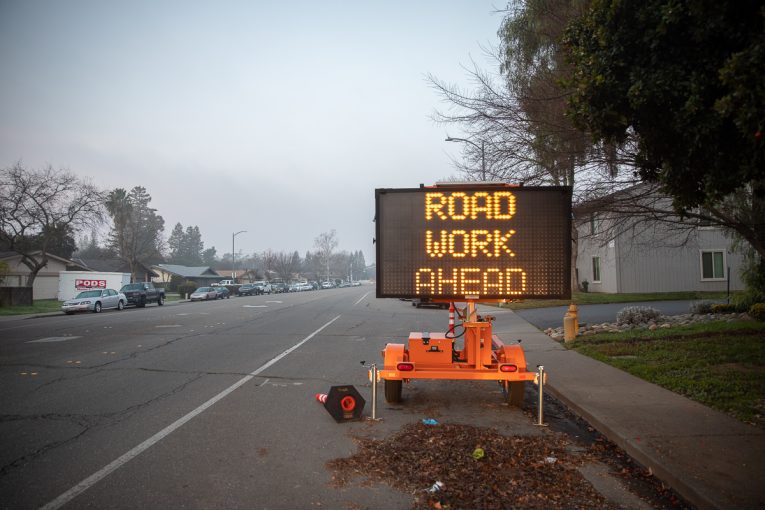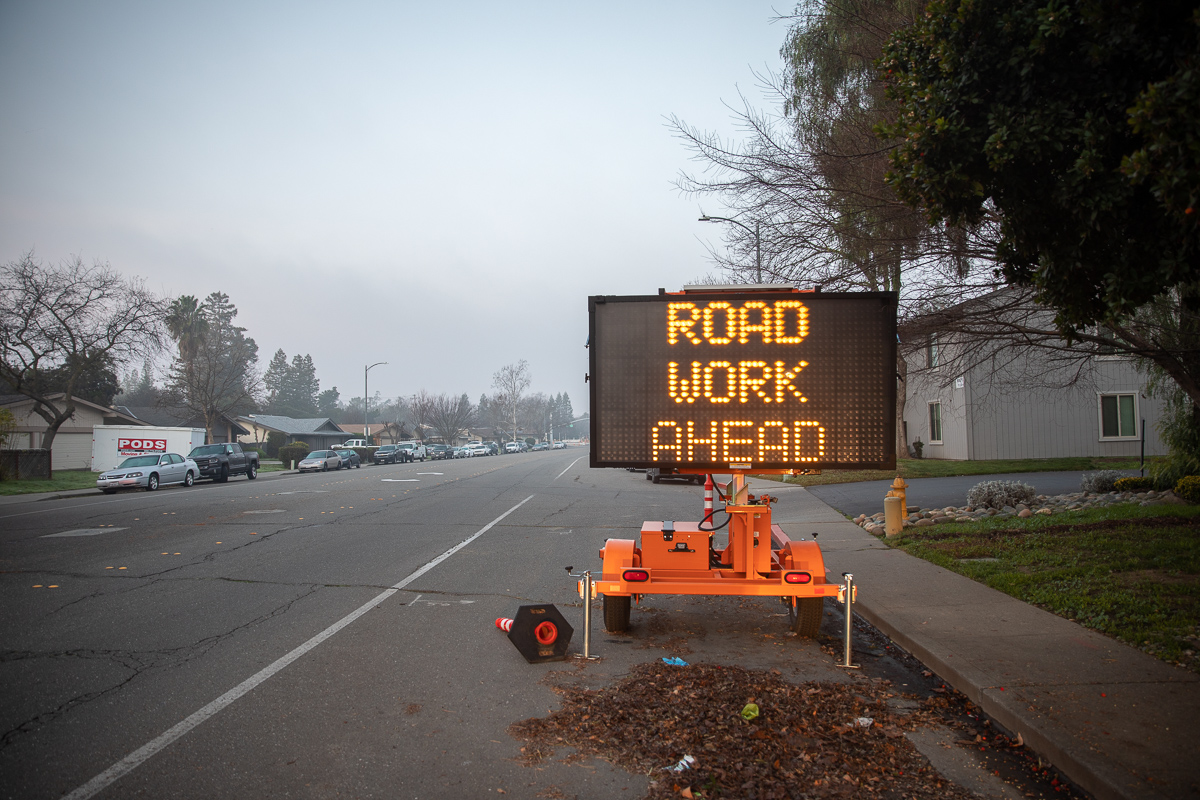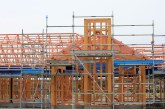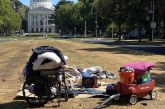

When the Davis City Council attempted to address the paid parking pushback, they installed a compromise that on paper seemed rather reasonable. With large numbers of businesses and citizens up in arms against the proposal for parking meters on downtown streets, they created a compromise by only putting parking meters on surface lots.
The problem, of course, is that their proposal was actually backwards – they put paid parking in surface lots that had excess capacity, but not on streets which do not.
This is best illustrated by my experience last summer and fall trying to navigate the downtown, with the Spencer Alley construction forcing me out of my PAID parking spot that I rent in the alleyway.
The experience is illustrative of the problem. Arriving downtown in the morning, I usually find street parking on G Street available up until about 11 am. However, by 11 it is no longer possible to find parking on G St., but you can find it in the G St. parking lot in front of what used to be Ace.
During lunch, that parking lot is jammed and you have to go up to the G and 4th garage, where there is always parking after the second level.
Coming back around 1:30 or so, you usually could not find parking on the street unless you happened to catch a car backing out of a spot, but could usually find one or two spots available in the G St. lot.
After about 4 pm, it was necessary to go park in the parking garage.
So here’s the thing that doesn’t make sense for the policy. The council is going to charge for the parking lot – where you can get spots – and not charge for the street, where you can’t.
Now flash forward to the Mace issue. The biggest problem with Mace from January to March was that I-80 traffic combined with road construction on Mace itself produced massive traffic back ups. But, as we have  pointed out, similar problems existed in winter 2017 as well, but they dissipated as it became spring.
pointed out, similar problems existed in winter 2017 as well, but they dissipated as it became spring.
But people on the Mace corridor have planted in their minds that the problem is the road redesign rather than conditions on I-80. You cannot convince many otherwise, even though the traffic was just as much a problem from the Mace Curve to the eastbound I-80 on-ramp in the southbound direction – an area unaffected by the road changes – as it was in the other direction headed northbound.
What’s more, the staff report even acknowledges that these changes are largely due to traffic on I-80 and Waze and may not be solved by going to two lanes again.
Observe the following.
The city cites at least three factors contributing to the problem: traffic congestion on eastbound I-80 which backs up past Richards Blvd., resulting in motorists exiting at Richards and bypassing freeway congestion by traveling east on Chiles through Mace, increasing congestion at the Mace Blvd./Chiles Road intersection.
Second, the Mace Blvd. on-ramps are backing up, and third, “Mobile and in-car navigation applications re-route freeway traffic in Dixon at the Pedrick Road interchange around the congestion via eastbound Tremont Road and northbound Mace Blvd.”
Staff believes that the project itself has likely contributed to congestion, both through the construction work and some of the design features, including the reduction from four to two automobile traffic lanes and the removal of right turn lanes at the Mace and Cowell intersection.
At the same time, they write: “Traffic congestion on Interstate 80 continues to increase, as does the use of navigation applications diverting drivers around it. This technology has also affected Cowell Blvd, Covell Blvd, and Second Street corridors. Given navigation applications algorithms route drivers based on travel time, peak traffic congestion relief from capacity-increasing design revisions may not endure, long term.”
Staff warns “routing more cars through the corridor may occur, resulting in similar congestion problems.”
In other words, increasing capacity may simply encourage the algorithms to direct more traffic through the corridor. We may make these changes, spend all this money, and it may not help at all.
I am also concerned with the attendees at the meeting two weeks ago. For the most part it was folks who were over 60. Not that there is anything wrong with that group of people, but we have a whole school in south Davis – Pioneer with a population of parents with school-aged children, several hundred of them, and none of them came to the meeting. The only child at this meeting was mine.
So council is proposing to make changes that staff acknowledges may not fix the problem, responding to a population that may not be representative of the overall population that utilizes the corridor or the Mace-Cowell intersection. And they may be solving a problem that really does not exist, other than for a brief period of time in the winter.
—David M. Greenwald reporting







Two possibilities…
Pogo was right: “we have met the enemy, and it is us”
Alternatively: “we have met the enemy, and it is everyone other than us”…
Applies to downtown parking, and transiting Mace…
There is also (upon reflection) the possibility that it is more than a bit of both…
There is a koan in there, somewhere…
Regarding the Council’s consideration of Mace changes, I received a copy of the following public comment sent to all the Council members, all the City Staff authors of the staff report, and the City Manager … with a copy to Supervisor Provenza
Weeds in Plantings on Cowell Blvd
.
New Drought Tolerant Planting on Cowell Blvd
Are you talking about the large river rocks in cement? Those are butt ugly and there is no drainage and they are heat islands. Boo. Discourage natural plantings? Seriously? To me that butt ugly river rock, and I’ve seen it elsewhere in town, is one of the worst features. Boo. Have you seen the natural drains that are being installed at many intersections with native plants. They are highly functional and aren’t heavy maint.
Alan, yes those are the local river rocks the public commenter is referring to. The problem with the natural (drought-tolerant) plantings is that unless they are regularly maintained they become weed magnets (as shown in the first picture). The Parks Department does not have the funding necessary to do the maintenance/upkeep work that is already on its plate, much less take on more work. The writing is on the wall that the weeds will be triumphant if the City decides to install drought tolerant plantings in the Mace median islands.
I haven’t seen any of the natural drains you are referring to. Give me an address and I’ll gladly go over and take a picture and post it to show the Vanguard readers what you are referring to.
There’s one in Sac next to new semi-high-rises near 15th and O I believe. I’ll send you a pix if I’m out that way. Minimal upkeep, drought tolerant native plants, loose rocks.
Alan, please do send me the pictures. I’ll post them when I get them from you.
“The Parks Department does not have the funding necessary to do the maintenance/upkeep work that is already on its plate, much less take on more work. The writing is on the wall that the weeds will be triumphant if the City decides to install drought tolerant plantings in the Mace median islands.”
Matt, based on a presentation to the NRC by the Parks department, this statement is not true as they are about to expand a weed control technology that is highly cost effective.
What is this technology?
Never mind, I found the minutes. If they are actually considering weed steaming technology, I hope they will consult with actual weed experts on the cost-effectiveness and efficacy. It gives variable results for different weed species, and is probably not as cost-effective as the use of herbicides. It may be more cost-effective than the gas-powered weed cutting they’re having to do now.
I suggest the technical advisory committee needs to get up and running, and shouldn’t be delayed by the difficulty they are having finding a new IPM Specialist. A lot of money could be wasted buying new machines that don’t actually work as well as promised. There’s plenty of research on weed steaming.
Richard, how effective is “weed steaming” going to be in controlling the weeds interspersed by Mother Nature in between the individual plants in a drought-tolerant planting? I doubt that the technology is that discrete in its application. Further, the last time I checked steam is water at a temperature in excess of 212 decrees … not exactly compatible with the typical flesh of drought-tolerant plants.
With that said, in response to a discussion with Alan Pryor at the Cool Davis event prior to the NRC meeting, I took several pictures of weeds in the areas along the North Davis Ponds Greenbelt that were mulched by Parks within the last 12 months. Alan had been assured during IPM (Integrated Pest Management) discussions with Parks that their mulching was fully effective in controlling weeds. As you can see by the two photos below, “full effective in controlling weeds” was/is a significant misstatement. With respect to Weed Control, human beings are severely handicapped any time they try and defeat Mother Nature when she has “home field advantage.”
Ahhh, Matt…
Remember the true definition of a weed… “a plant not wanted where it grows”… an apple tree springing up in a wheat field is a “weed”… as is a rose springing up in an alfalfa field… perspective… plants growing thru and destroying bike/ped paths is either a nuisance, or nature asserting itself…
Same for humans and human behavior… can be a great ‘gift’, or a ‘weed’…
Bill Marshall said . . . “plants growing thru and destroying bike/ped paths is either a nuisance, or nature asserting itself…”
Or both
I completely agree with this assessment and with the other comments from this landscape professional.
I agree with the article as a whole. But Mace will probably be fixed by being “Davis-parking-“solution”-ified”.
(Before parking, there was LITS, of course)
It is what I’m afraid of as well… the perfect compromise that gives nobody what they want or need. I just decided not to say it out loud. It’s your fault now.
It is my fault.
>> parents with school-aged children, several hundred of them, and none of them came to the meeting <<
It is not true that none of them came to the meeting. It is true that for the most part the parents are too intimidated to speak out. I agree that most of the “loud and angry” crew appear to be as you describe: over 60 and without kids in school.
I agree with Darell. I have attended all three meetings. At the March 28th after 40 or 50 people had voiced their complaints with the project, its design and its management, one young parent got up and voiced support for the project (as it exists right now). He was booed by the bulk of the 120+ people in attendance, and someone had to yell “Let him speak!” in order to quiet the boo birds. He didn’t have his kids with him, but I can imagine having their father treated like that would have left an impression on them.
Matt Williams said:
This whole process sounds like a travesty from the way the meetings were handled to the way City officials have made decisions to modify a not-even-completed project without identifying whether there are any actual significant operational problems with it yet, and more! In city planning grad school ages ago we had one class that covered a lot of case studies of planning processes gone awry. This would be a great addition to that portfolio!
Find myself in rare agreement with Keller
I also agree with you that some of the “appeasement” changes being suggested will not further the goal of this redesign, nor will they ultimately solve what most of the complainers are complaining about.
Before construction began, the local motorists were complaining about congestion and speeding. And they blamed it all on Waze. That all seems to be forgotten today, and everything is blamed on the city… with this idea that more Mace lanes can magically shove more cars on onto the stopped freeway.
In the meantime, those without school kids haven’t seemed to notice any problems for people who our outside of cars.